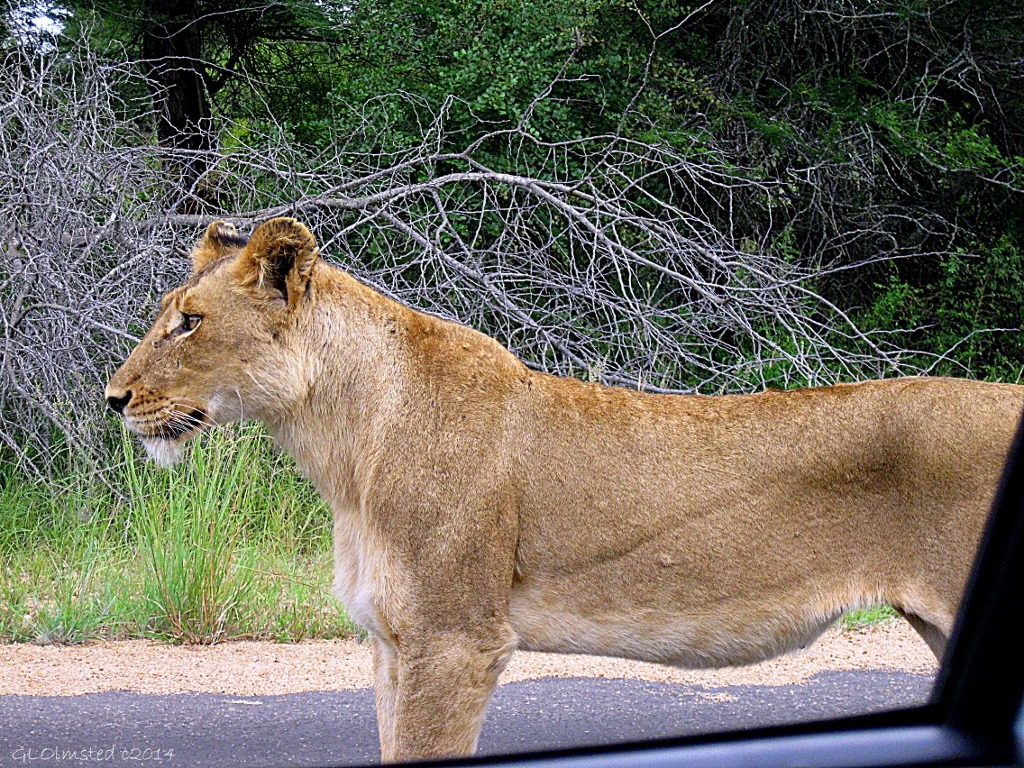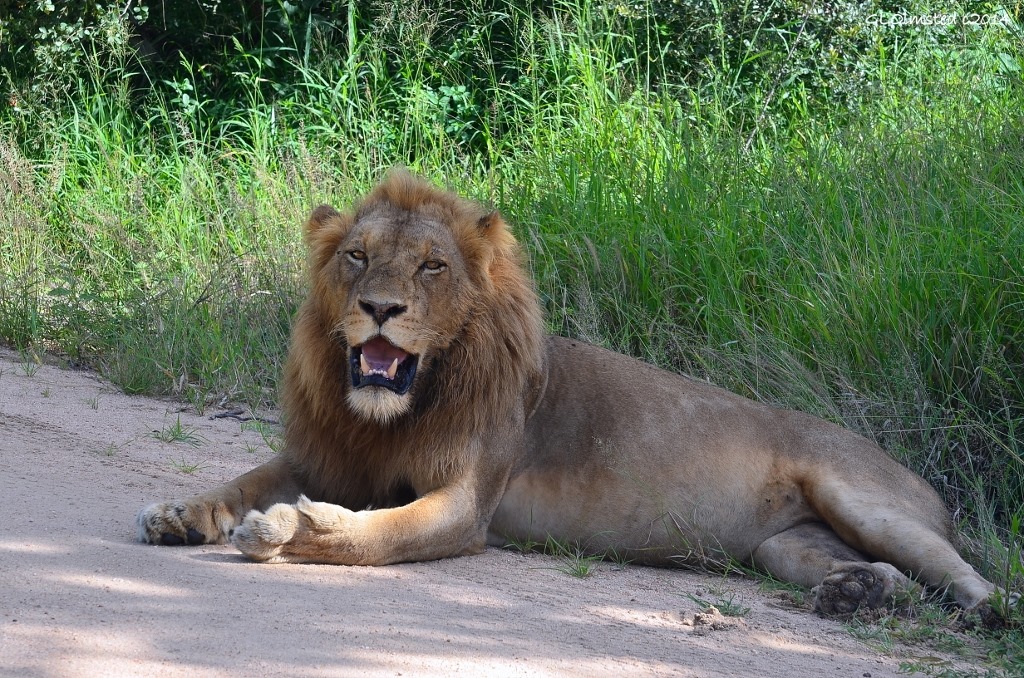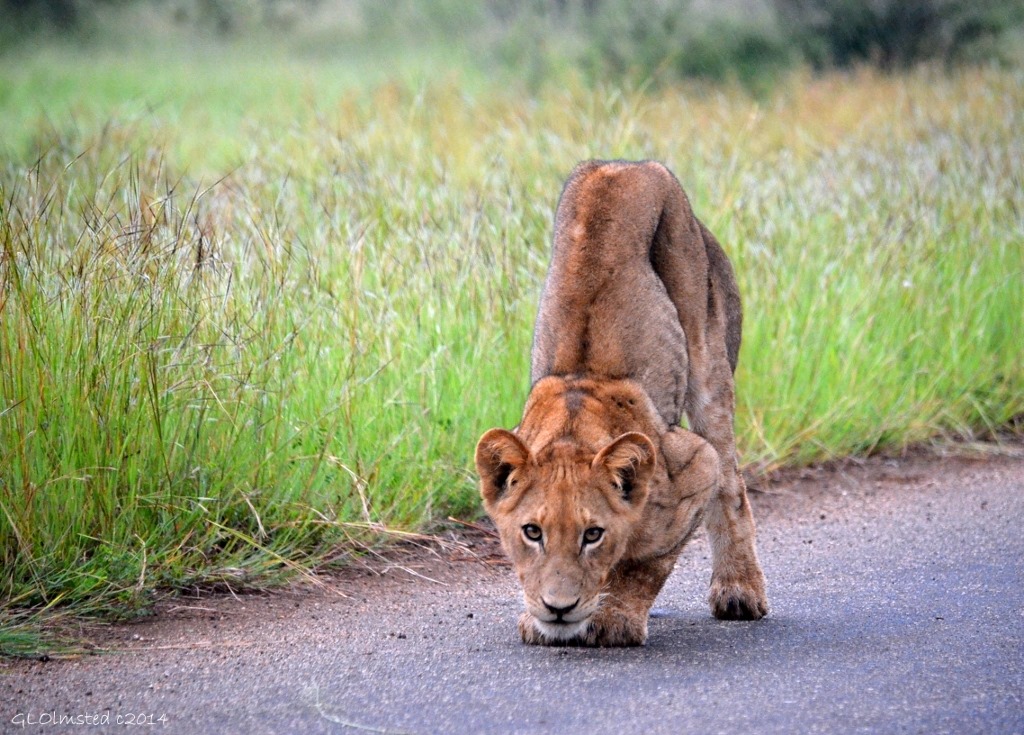 My heart stopped beating and breath came in gasps as the lioness strolled past only five feet from the open window of our truck in Kruger National Park, South Africa. I felt honored to see this iconic species of strength and courage before only seen in photographs, adorning flags, decorating coins and as guarding sculptures.
My heart stopped beating and breath came in gasps as the lioness strolled past only five feet from the open window of our truck in Kruger National Park, South Africa. I felt honored to see this iconic species of strength and courage before only seen in photographs, adorning flags, decorating coins and as guarding sculptures.
 August 10 is World Lion Day 2014, a day set aside to create much needed conservation awareness for a ‘beast’ revered by people throughout history. Yet lions could become extinct, then our descendants will only know them in zoos or stories. Let us celebrate the life of lions and not their demise.
August 10 is World Lion Day 2014, a day set aside to create much needed conservation awareness for a ‘beast’ revered by people throughout history. Yet lions could become extinct, then our descendants will only know them in zoos or stories. Let us celebrate the life of lions and not their demise.
 According to the world’s foremost lion expert Craig Packer, “The first true lion probably padded over the earth about 600,000 years ago, and its descendants eventually ruled a greater range than any other wild land mammal. They penetrated all of Africa, except for the deepest rain forests of the Congo Basin and driest parts of the Sahara, and every continent save Australia and Antarctica. There were lions in Great Britain, Russia and Peru; they were plentiful in Alaska and the habitat known today as downtown Los Angeles.
According to the world’s foremost lion expert Craig Packer, “The first true lion probably padded over the earth about 600,000 years ago, and its descendants eventually ruled a greater range than any other wild land mammal. They penetrated all of Africa, except for the deepest rain forests of the Congo Basin and driest parts of the Sahara, and every continent save Australia and Antarctica. There were lions in Great Britain, Russia and Peru; they were plentiful in Alaska and the habitat known today as downtown Los Angeles.
“The lions’ decline began about 12,000 years ago. Prehistoric human beings, with their improving hunting technologies, probably competed with lions for prey, and lion subspecies in Europe and the Americas went extinct. Other subspecies were common in India and Africa until the 1800s, when European colonists began killing lions on safaris and clearing the land. In 1920, a hunter shot the last known member of the North African subspecies in Morocco. Today, the only wild lions outside Africa belong to a small group of fewer than 400 Asiatic lions in the Gir Forest of India.”
 The lion is a vulnerable species, having seen a major population decline in its African range of 30–50% per two decades during the second half of the 20th century.
The lion is a vulnerable species, having seen a major population decline in its African range of 30–50% per two decades during the second half of the 20th century.
 Lions are the only cats that live in groups called prides, a family unit that may include up to three males, a dozen or so females, and their young. All of a pride’s lionesses are related, and female cubs typically stay with the group as they age. Young males eventually leave and establish their own prides by taking over a group headed by another male. The pride often works together defending themselves against other lions.
Lions are the only cats that live in groups called prides, a family unit that may include up to three males, a dozen or so females, and their young. All of a pride’s lionesses are related, and female cubs typically stay with the group as they age. Young males eventually leave and establish their own prides by taking over a group headed by another male. The pride often works together defending themselves against other lions.
 Female lions mate about every two years, giving birth to one to six cubs after a three-and-half-month gestation period. About 60 to 70 percent of cubs die within the first year of their life.
Female lions mate about every two years, giving birth to one to six cubs after a three-and-half-month gestation period. About 60 to 70 percent of cubs die within the first year of their life.
 Males defend the pride’s territory, which may include some 100 square miles (259 square kilometers) of grasslands, scrub, or open woodlands.
Males defend the pride’s territory, which may include some 100 square miles (259 square kilometers) of grasslands, scrub, or open woodlands.
 Female lions are the pride’s primary hunters. They often work together to prey upon antelopes, zebras, wildebeest, and other large animals of the open grasslands. Many of these animals are faster than lions, so teamwork pays off.
Female lions are the pride’s primary hunters. They often work together to prey upon antelopes, zebras, wildebeest, and other large animals of the open grasslands. Many of these animals are faster than lions, so teamwork pays off.
 Most hunting takes place under the poor light conditions of early evening or dawn, and during the night. If suitable prey is available, lions eat every 3 to 4 days, but can go without food for more than a week. They sleep roughly 20 hours a day.
Most hunting takes place under the poor light conditions of early evening or dawn, and during the night. If suitable prey is available, lions eat every 3 to 4 days, but can go without food for more than a week. They sleep roughly 20 hours a day.
 Several organizations support projects to protect lions through community conservation education, research, public awareness, habitat management and restoration.
Several organizations support projects to protect lions through community conservation education, research, public awareness, habitat management and restoration.
* The Lion Conservation Fund (LCF) supports projects that will determine the distribution and abundance of African lions in areas of great global conservation importance. They are committed to supporting conservation and research initiatives to better our understanding of lion behavior, ecology, and biology. They are also working to protect the habitats of these magnificent animals while improving the lives of people sharing habitat with lions in Africa.
* The African Wildlife Foundation founded the Ewaso Lions Project in 2007 to address the issues facing lions through scientific research and community outreach programs to promote human-carnivore coexistence.
* Much of Born Free’s lion conservation work is conducted in Kenya, one of the last remaining strongholds for the species, through a core partnership with the Kenya Wildlife Service (KWS) and focuses primarily on actions aimed at reducing human-predator conflict. They seek to find ways for lions and people to live together in the same landscape.
* Wildlife Conservation Society collaborates with grassroots projects designed to restore tolerance for lions among local communities and assist herders in protecting cattle and sheep.
We can spread the word about lion conservation and donate to help support these organizations.
 Even if I never see lions again I want to know they are alive and well, growing in population as their habitats allow. I want to believe my great-great-grandchildren and beyond will have the chance to see lions in the wild.
Even if I never see lions again I want to know they are alive and well, growing in population as their habitats allow. I want to believe my great-great-grandchildren and beyond will have the chance to see lions in the wild.
How about you? Want to see lions in the wild?
For more amazing photos of lions check out safari guide Coral Wild.
